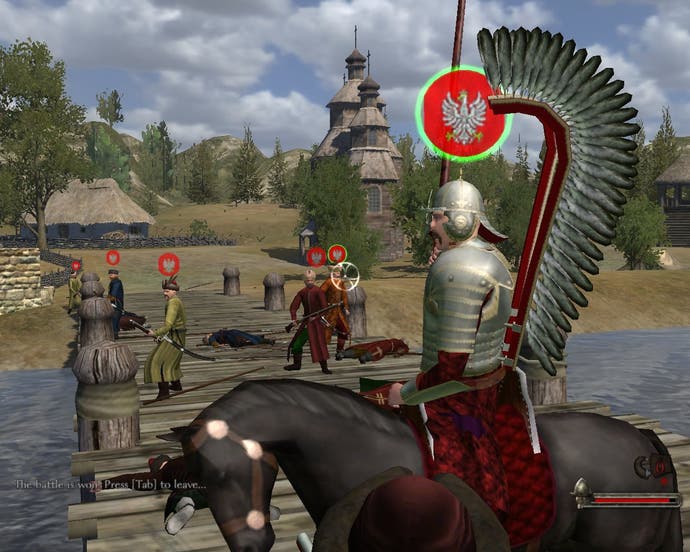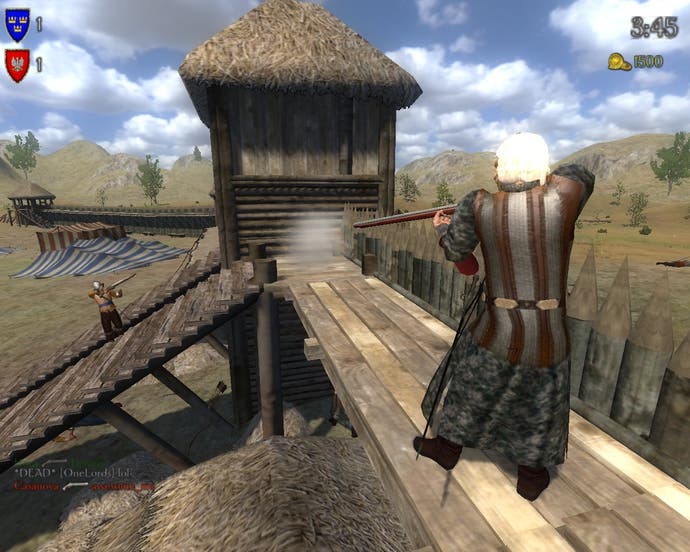Mount & Blade: With Fire & Sword
Chivalry or gunnery? Take your pike.
The closest thing to Warband's tense and lucrative arena scraps are squalid pub-car-park fist fights. Most taverns in With Fire & Sword seem to boast a drunk willing to hazard a few coins on a bare-knuckle bout. Accept and you're whisked outside into an empty yard or street for a few minutes of grunty lunging. If these sessions involved a ring of baying locals or occasionally degenerated into mass brawls, they might have been more appealing. As it is, they're pretty tiresome.
In an era when every self-respecting rake had a pistol on his hip, and every self-respecting landlord a cellar full of vodka, it's sad that duels, impromptu shooting contests and drinking games aren't part of the rich tapestry of urban life. Combine the three - maybe mix in a little bear-baiting or Beard Tax collecting, for good measure - and you'd have, well, something a damn sight more interesting than what you have at the moment.
One of the odder omissions is the absence of female player-characters. Instead of the Warband system where you got to choose the sex and back-story of your hero, character-creation in With Fire & Sword involves stat distribution, (male) face sculpting and nothing else. More dye leached from Mount & Blade's bright vestments for no discernible gain.

Happily, not all of the changes are negative. The new wagon fort capability, for example, is 98 per cent splendid. For an old wargamer like myself, one of the more annoying aspects of Mount & Blade has always been the fact that, when being chased down by a superior force on the campaign map, you can't seek out a nice defensible hill, ruin or river crossing and await the inevitable clash. The new ability to circle wagons into a defensive laager in the moments before armies meet goes a long way to banishing that annoyance.
I'm also enjoying some of the economic tweaks. Though figuring out profitable trade runs early on is still a pain, thanks to an unhelpful interface, it's great that we finally get to organise goods caravans in addition to raiding and shepherding them. Once you've built up enough capital to invest in your first, and recruited the few dozen mercs necessary to keep it safe, you'll never look back. Profits can be squirrelled away in banks too, meaning that mid-game, you can be off climbing the greasy pole (or clobbering him, if you prefer) while compound interest pays your army's wages and bar bills.

Not that all of With Fire & Sword's armies require remuneration. Captain, the new multiplayer mode, lets you play team deathmatch with a squad of slavishly obedient bots at your side. As these micro-armies are controlled with the same crude interface as single-player ones, parade-ground precision and disciplined volley firing isn't possible. Still, it's a welcome step down the road to that mash-up of Mount & Blade and Total War that tops my 'Why Has Nobody Made...' list. Getting a Mount & Blade multiplayer team to work together can be a near-impossible task. Captain does at least give the illusion of coordination.
The worst accusation I can hurl at With Fire & Sword is also the kindest compliment I can pay it. Despite the new setting, infernal weaponry and bespoke story quests, most of the time the game plays just like Warband or the original Mount & Blade. The majority of the bread-and-butter activities are nigh identical, as is the pace and pattern of play. Once the novelty of gunpowder has worn off, series veterans may find themselves wandering back to familiar pastures - or wondering whether one of the tastier Caravanserai offerings (some of which also supply musket action) wouldn't have provided as much pleasure.